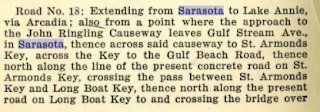Florida State Road 789 departs from US Route 41 in downtown Sarasota and follows the Gulf Coast towards Florida State Road 64 at Anna Maria Key. Headed northbound Florida State Road 789 crosses John Ringling Causeway and emerges into the unique Harding Circle of St. Armands Key. Harding Circle is often more popularly referred to as "St. Armands Circle" and is a central attraction for visitors to the City of Sarasota.
Part 1; the history of Harding Circle
Information pertaining to the history of Harding Circle is easily found at the intersection with western John Ringling Boulevard. St. Armands Key is named after French investor Charles St. Armands who purchased the island in 1893. St. Armands Key was later purchased by Circus Magnate John Ringling in 1923. Ringling sought to build a planned community which would be centered around a circle shaped main street and park. The grand opening of St. Armands Key and Harding Circle would come in 1928 when the first John Ringling Causeway was completed to downtown Sarasota. Harding Circle is named after Warren G. Harding who was the residing President when the street grid of St. Armands Key was being planned.
Note; several sources claim the first automobile to reach St. Armands Key from Sarasota arrived in 1926. It is unclear if a ferry was required to make this trip to St. Armands Key or if the original John Ringling Causeway was constructed to a point where vehicles could cross. The below postcard from bridgehunter.com depicts the original John Ringling Causeway.
John Ringling Causeway first appear as an extension of pre-1945 State Road 18 for the first time in the 1935 Florida State Road System logbook. The extension of pre-1945 Florida State Road 18 was intended to connect the highway to Florida State Road 18A at Anna Maria Key. Pre-1945 Florida State Road 18 appears to have bypassed Harding Circle in favor of Washington Drive.
John Ringling Causeway can be seen as part of pre-1945 Florida State Road 18 on the 1939 Rand McNally Map of Florida.
During the 1945 Florida State Road Renumbering John Ringling Causeway were reassigned as Florida State Road 780. Florida State Road 780 can be seen on the 1956 Shell Highway Map of Florida.
The second John Ringling Causeway opened to traffic during 1957 and can be seen on this postcard hosted on bridgehunter.com. The second John Ringling Causeway was a replacement for the original structure which had been completed during 1928.
In time Florida State Road 780 over John Ringling Causeway was renumbered as Florida State Road 790. This designation swap appears to occurred alongside Florida State Road 780 departing northward from St. Armands Key being reassigned as Florida State Road 789. Around the turn of the 21st Century Florida State Road 789 was extended from St. Armands Key to downtown Sarasota. In 2001 Harding Circle was designated as a National Historic District and placed on the National Register of Historic Places. In 2003 the third John Ringling Causeway replaced the second structure. It appears the opening of the third John Ringling Causeway coincided with Florida State Road 789 moving from Washington Drive to Harding Circle.
Below the present John Ringling Causeway can be seen from Nora Patterson Bay Island Park. The current John Ringling Causeway is 3,097 feet in length and does not have a draw span unlike it's two predecessors.
Part 2; a tour around Harding Circle
From John Ringling Causeway Florida State Road 789 enters Harding Circle facing westward. Traffic headed onto northbound Florida State Road 789 towards Longboat Key is advised to utilize both lanes.
A closer view of Florida State Road 789 northbound transitioning from Harding Circle to northern Boulevard of the Presidents towards Longboat Key.
Florida State Road 789 continues to loop Harding Circle and approaches western John Ringling Boulevard where traffic is advised Lido Key can be accessed.
The street blades of Harding Circle show it now signed as St. Armands Circle.
Florida State Road 789 traversing Harding Circle to southern Boulevard of the Presidents.
A statue of John Ringling located at Harding Circle and southern Boulevard of the Presidents.
Florida State Road 789 completing the full loop of Harding Circle back towards eastern John Ringling Boulevard towards the John Ringling Causeway.




























Comments